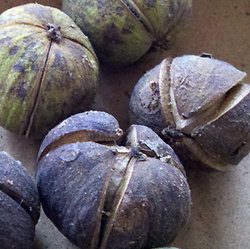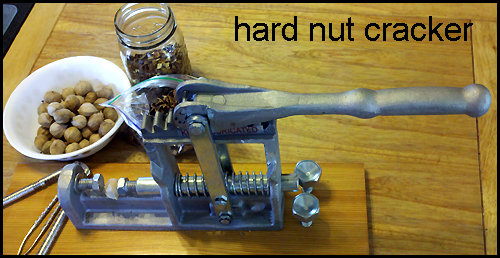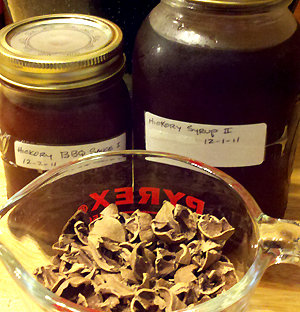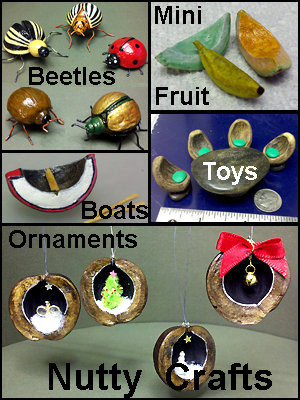





Do you have hickory trees on or near your property? Then you may have a great food source; a necessary component for grilling and smoking meat and fish; recycling materials for the yard and garden, and with a little imagination, a bonus resource for craft projects.
I had the good fortune to receive a few large bags of fresh shagbark hickory nuts from a dear friend (thanks Pam!). Hickory nuts are very hard and small, and not worth the effort to extract the nutmeats for some people. I adore their unique aroma and flavor, so I disagree.
The best tasting varieties of hickories are the shagbark, Carya ovata; shellbark, Carya laciniosa; and mockernut, Carya alba. Other varieties can be bitter and not be worth your trouble. Hickory trees can hybridize in the wild making identification difficult, so consult a tree guide to get a better idea of what may be growing near you. I have listed a couple Internet sites at the bottom of this article that I found very useful in determining the varieties of hickory trees.
 It takes a little time to retrieve the actual hickory nut because the husks need to be removed. It is incredibly messy to attempt removing the husks while they are still green, so it is best to let them dry out for a few days by spreading out your harvest in a single layer on cloths or shallow boxes. Some folks choose to wash the hickories before laying they out to dry. I never have, but assume a wet and muddy fall harvest would definitely dictate a change in my opinion.
It takes a little time to retrieve the actual hickory nut because the husks need to be removed. It is incredibly messy to attempt removing the husks while they are still green, so it is best to let them dry out for a few days by spreading out your harvest in a single layer on cloths or shallow boxes. Some folks choose to wash the hickories before laying they out to dry. I never have, but assume a wet and muddy fall harvest would definitely dictate a change in my opinion.
The husks will begin splitting open and pull away from the nutshell as they dry. Most of the husks will come off very easily when ready. A few may need the prying encouragement from a flat blade screwdriver or butter knife. The drying period also allows any grubs to find their way out of the shells making it easier to identify the bad nuts. Throw out any nuts that have holes because there is nothing left inside you would care to eat!
Do not throw out the husks; they can be used for other purposes. Let them completely dry out and become woody before storing as they can develop mildew or mold. Read further along in this article for additional uses.
Once the husks are removed, you can start cracking. If you have a large quantity, you might want to let the nuts continue to dry out in the same manner as before (single layer) so they won't get moldy by the time you get around to cracking the last one.
Continue to check for any squirmy varmints and discard nuts with holes. The Native American Indians would put the hulled nuts into a pot of water and discard any that floated, as that indicated bad ones. [1] After drying, you can gather the whole nuts into sealable containers to freeze. Freezing is supposed to make the nutshell more brittle and less difficult to crack. Boiling is also a method suggested to help soften the shells, something I have not tried.
There are as many methods to crack open a hickory nut as there are hickory nut lovers (including the squirrels). We each develop a formula that seems to require pliers, rocks, and/or hammers, applied to a solid hard surface. You will smash a few hickory nuts beyond eating, along with a few fingers, until you get the hang of it. There is said to be a perfect "sweet spot" to strike at the shoulder of the nut for best cracking results, according to an article in Mother Earth News.[2]
If you get discouraged, tired, or wounded, as I did, you may consider purchasing a "hard nut" cracker traditionally used for black walnuts, to open your little gems. I did, and I am thrilled with it! My brain started justifying the expense with the more nuts (and fingers) I smashed, and the sticker shock of $30 to $40 became a bargain in the end! I am most definitely ready for next year's hickory harvest and possibly black walnuts, too, now that I have the dandy nutcracker!
Do not throw out those hickory nutshells! You can get more mileage out of them, so read on!
 Hickories are in the same family as walnuts and pecans, have similar nutrition, and can be substituted in recipes for either nut. The flavor of the hickory nut is somewhere between the English walnut and the pecan, but wonderfully distinct. They make great additions to baked goods, and candies (like fudge), as well as many savory dishes.
Hickories are in the same family as walnuts and pecans, have similar nutrition, and can be substituted in recipes for either nut. The flavor of the hickory nut is somewhere between the English walnut and the pecan, but wonderfully distinct. They make great additions to baked goods, and candies (like fudge), as well as many savory dishes.
Native American Indians utilized hickory nuts as a staple food source by crushing the nuts and shells into a coarse meal to boil in water. They would draw off the oil for various uses, and use the nutritious milk broth that was left as a base for soups and stews, as a beverage, and to sweeten and flavor many of their dishes.[1]
I tried to make hickory syrup last year according to Sally Miller's inspiring article, The elusive hickory syrup, using the bark of a shagbark hickory without success. This year I had great luck in making the sought-after syrup with the shells leftover from cracking the nuts, along with a small handful of the nutmeats. I boiled them for hours to allow the liquid to become a deep brown color, let them cool, then strained the shells away from the brown liqueur. I added 1-1/2 cups of sugar per cup of hickory liquid and brought it to a boil over medium heat. FYI: Too much sugar may cause crystallization after cooling. I let the pot simmer until the syrup was the consistency I wanted. I store the finished syrup in the fridge because I intend to use it up soon, but it can be processed in a boiling water bath canner for long-term storage (consult a good canning guide for more information).
I used the hickory syrup to create the ultimate barbeque sauce by modifying a few recipes I found in cookbooks and on the Internet. There is no comparison between the taste of it and the store brands!
Do not throw out those hickory nutshells just yet! Read on . . .
After straining away from the liquid to make syrup, place the nutshells on paper towels to dry, and then transfer to a baking sheet to roast in the oven on 200 degrees F for an hour. Let them cool before storing in plastic zip bags for the grill and smoker.
Use 1 cup or 1/4 pound of water-soaked nutshells on the grill for a choice hickory-flavored treat! The water soaking will create smoke and make them last longer on the grill. In addition, the dry hot nutshells will flare-up and jump around some. Soaking will ensure plenty of smoke for curing meat and fish. I was told that the nutshells would yield a better flavor than the commercially packaged hickory wood chips and planks. I will find out soon enough.
FYI: Do not use the nutshells in fireplaces without a spark fence, as the shells will flare up and dart around.
Hickories, being in the Juglandaceae family, contain a small amount of the toxin juglone, but nowhere near the quantities as its cousin the black walnut. Composting the leaves, husks, and nutshells, helps reduce the toxins, but your tomatoes may still wilt with too much repeated use of hickory-based mulch.
The nutshells will decompose quickly if crushed into fine bits. Both the nutshells and husks make nice decorative mulches around the acid-loving plants in the yard, too.
The greatest objection to hickory trees may be the amount of shade they cast onto the yard depriving grass and other plants of needed sunlight, although maybe not much of an issue during the hot summer in the warmer zones. Harvesting the fallen nuts, or piling them away from the trees, out of the shade and into the sun, may benefit both you and your yard while speeding their decomposition and removing the concentration of acid and juglone from one centralized area.
 When the husks dry out completely, they are like wood that can be carved, sanded, stained, and painted. Your imagination is the only limit to what you can make from them.
When the husks dry out completely, they are like wood that can be carved, sanded, stained, and painted. Your imagination is the only limit to what you can make from them.
Most of the husks will come off the nut in quarters that look like little boats or slices of melon; therefore, I painted a few to look like my favorite fruits, and then fashioned a few more into tiny boats for use in my miniature gardens, terrariums, dollhouse, and other displays.
Most of the husks that remained in halves had slight splits between the quarters that reminded me of giant beetles. I attached wooden beads for the head and thorax, wires for the legs and antennae, and then painted them to look like the known beetles in our area. I believe kids would have a lot of fun making fantasy bugs during the winter months for future garden art, flower pot decoration, and possible practical jokes on fellow gardeners (king and queen beetles attacking the garden, oh my!).
I was lucky enough to have husk halves that were solid, without splits, to convert into dioramic Christmas tree ornaments. I plan to use them in a similar fashion as dollhouse niches, toad house windows, and much more.
If you have access to hickory trees in your area, I hope I have given you plenty of good reasons to relish, and even look forward to, the harvesting of their bounty in the fall.
Copyright © www.100flowers.win Botanic Garden All Rights Reserved